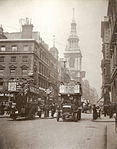Russia Row
Muscovy CompanyPages containing links to subscription-only contentStreets in the City of London

Russia Row is a street in the City of London that runs between Milk Street and Trump Street on the northern side of the former Honey Lane Market. Russia Court, formerly Robin Hood Court, the home of the Russia Company, was once located on the northern side of the street and the City of London School on the south side. The street is thought to have received its name around 1804, shortly before Russia decided to enter the Napoleonic Wars on the same side as Britain. It was damaged by German bombing during the Second World War and has since been completely rebuilt.
Excerpt from the Wikipedia article Russia Row (License: CC BY-SA 3.0, Authors, Images).Russia Row
Gresham Street, City of London
Geographical coordinates (GPS) Address Nearby Places Show on map
Geographical coordinates (GPS)
| Latitude | Longitude |
|---|---|
| N 51.51459 ° | E -0.09326 ° |
Address
Commerzbank
Gresham Street 30
EC2V 7PG City of London
England, United Kingdom
Open on Google Maps











